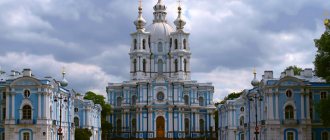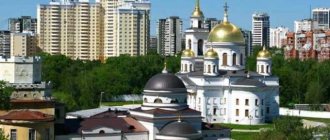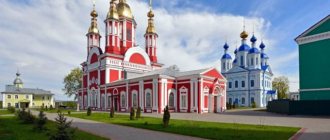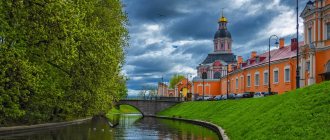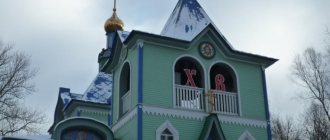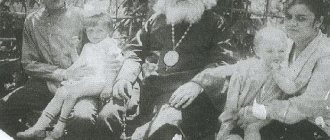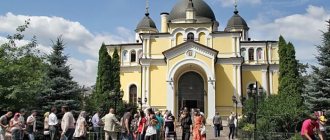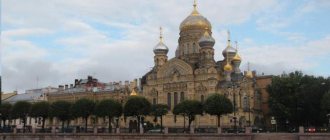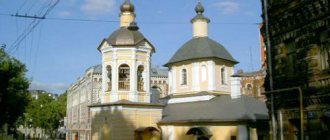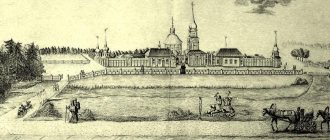Story
St. John's Convent appeared thanks to the desire of St. John of Kronstadt to build a monastery in honor of the name of his heavenly patron.
The construction permit was issued in 1900, and within 2 years the majestic Cathedral of the Twelve Apostles with two chapels was built
The construction of the premises , which soon made up the entire monastery complex, continued for another 8 years . Were built:
- cells
- residential buildings for pilgrims
- hospital
- icon painting workshops
lined with white Italian marble was built in the basement of the cathedral
John of Kronstadt received permission to be buried in the tomb of the Ioanovsky Monastery several years before his death, making a special request to the Metropolitan
The holy father died in 1908, and soon miraculous healings began to occur , of which about ten were counted in 1909 alone.
By 1917, the monastery became one of the most important centers of spiritual life and monastic crafts of the St. Petersburg diocese
The following people worked at the monastery:
- icon painting workshops
- shelter for girls left without parents
- infirmary
At that time, about 350 nuns permanently lived at the monastery: nuns, sisters preparing for monastic vows, novices. Crowds of pilgrims came to the monastery every day.
The monastery was closed after the establishment of Soviet power, and its nuns became members of the labor artel. In the early 1930s, clergy and nuns were arrested and exiled to camps, and the buildings of the monastery complex were handed over to local authorities.
The monastery complex was returned to the Diocese in 1989. Work began on the restoration of the temples. Today, all the premises of the monastery have been restored, the monastery has been restored to its original appearance.
Monasteries of St. Petersburg - the four hearts of the city on the Neva
Today, within the urban area, there are two monasteries and two monasteries. Their fate is closely connected with the history of the city. In the 20th century, the old monasteries had to go through difficult trials. Today, Orthodox monasteries are being restored and attract many pilgrims and tourists.
Alexander Nevsky Lavra
General view of the Alexander Nevsky Lavra
In our country there are only two large monasteries with a special status. One Lavra is located in Sergiev Posad, and the other is in the cultural capital of Russia.
The Alexander Nevsky Lavra was founded by Tsar Peter I in honor of the victory in the long-term and bloody war between Russia and Sweden.
At the beginning of the 18th century, there was only one wooden church in the monastery, but already in 1717 stone construction began according to the design of the talented architect Domenico Trezzini. The monastery received Lavra status in 1797.
After the revolution, the monastery ensemble was recognized as an architectural monument, but for several decades the buildings were used by the House of Pioneers and a school. There were warehouses, a motor depot and dormitories for workers. Only in the mid-1990s was the ancient monastery returned to believers.
View of the Annunciation Church and the Annunciation Gate of the Alexander Nevsky Lavra
The central place in the monastery is occupied by the majestic Holy Trinity Cathedral, built in the second half of the 18th century. The oldest surviving temple is the Church of the Annunciation. Members of the imperial family, Russian statesmen and diplomats are buried in her tomb.
The main shrine of the Lavra is the relics of the blessed prince Alexander Nevsky, which were returned to the monastery in 1989. Tourists come here to see ancient temples and visit unique memorial necropolises.
The oldest Lazarevskoye cemetery was created in the 18th century. Masters of art and writers are buried at the Tikhvin necropolis: composers A. S. Arensky, M. A. Balakirev, D. S. Bortnyansky and M. P. Mussorgsky, poets E. A Baratynsky, V. A. Zhukovsky and A. A. Delvig, writers F. M. Dostoevsky and N. M. Karamzin. On their graves you can see beautiful monuments and tombstones.
General view of the Trinity Cathedral of the Alexander Nevsky Lavra
Lavra cemeteries are open daily from 10:00 to 17:30. Ticket costs 250 rubles (2019). Please note that the box office stops selling tickets half an hour before closing.
Divine services.
Services in the monastery churches are held from Monday to Saturday at 7:00, 10:00 and 17:00. On Sundays, the liturgy begins at 9:00.
How to get there.
The Lavra is located on the left bank of the Neva, near the Alexander Nevsky Square metro station.
Holy Trinity Sergius Primorskaya Hermitage
General view of the Sergievo Primorskaya Hermitage
The monastery appeared during the reign of the Russian Empress Anna Ioannovna. The Empress granted the monk the country estate of her sister - a manor, which had previously belonged to Princess Ekaterina Ioannovna.
The new monastery occupied a modest plot of land with a wooden fence. There was a small temple in the middle, and around it there were cells for the monks and the abbot’s house. In the 1750-1760s, the architect Pietro Antonio Trezzini drew up a project, and the wooden buildings were rebuilt in stone.
The heyday of the monastery came in the 1830s, when Archimandrite Ignatius (Brianchaninov) was its rector. Under him, the fraternal buildings were connected by a gallery, and the monastery churches were completely renovated.
View of the Sergievo Primorskaya Hermitage from the St. Petersburg Highway
Before the revolution, there were 7 churches in the desert, and 100 monks lived. Then the situation in the country changed dramatically. In 1919 the monastery was closed. Some of the monks were sent into exile, and some were left to live in a children's labor commune created here.
The architectural ensemble suffered greatly in the 1930s and during the war. In 1960, during N.S. Khrushchev’s struggle with religion, the ancient Trinity Cathedral was blown up.
Today the Holy Trinity Sergius Hermitage is a functioning monastery. Several churches from the 18th-19th centuries and the burial place of the Russian diplomat and statesman, Prince Alexander, Mikhailovich Gorchakov, have been preserved here. Some buildings have been restored, but some buildings still need restoration.
Icon of Christ the Savior above the holy gate
Divine services.
The men's monastery is open to pilgrims and tourists from 7:30 to 21:00. Church services are held every day: on weekdays at 9:00 and 17:00, and on Saturday and Sunday at 10:00 and 17:00.
How to get there.
The monastery is located at the exit from the city towards Peterhof - on St. Petersburg Highway, 15. If you want to travel by train, get off at the Sergievo station. Buses and minibuses run from the Avtovo, Prospekt Veteranov, Leninsky Prospekt and Baltiyskaya metro stations. You need to get off at the Prospekt Budenny stop.
St. John's Monastery
View of the Ioannovsky Monastery from the Karpovsky Bridge
On the banks of a tributary of the Neva, the small Karpovka River, stands a magnificent monastery ensemble in the neo-Byzantine style. The Orthodox monastery was founded at the beginning of the last century by a revered priest, John of Kronstadt. The monastery is dedicated to John of Rila, a Bulgarian saint who lived in the 10th century. The relics of John of Kronstadt rest in the tomb temple.
The unusual buildings were built according to the design of the St. Petersburg architect Nikolai Nikitich Nikonov. Before the revolution, 350 nuns and novices lived here. They had their own farming, worked in a hospital, an orphanage and workshops. During the First World War, the nuns set up an infirmary and nursed wounded soldiers and officers.
In 1919, instead of the monastery, a labor commune appeared. Then the buildings were given to the reclamation technical school, and the nuns were arrested and sent into exile in Kazakhstan.
Domes of the Church of the Twelve Apostles of St. John's Monastery
The old monastery was returned to the Church in 1989. Within a few years, the offices that occupied the former churches moved out, and since 1991, monastic life went on as usual.
Temples and other buildings were restored or rebuilt according to surviving drawings and photographs. Today on the territory you can see the huge Temple of the Twelve Apostles, the Church of St. John of Rylsky, the Intercession Chapel and the tomb.
Divine services.
Believers can come to services daily at 8:00 and 17:00. On Sunday, the Liturgy begins at 9:00.
How to get there.
The monastery is located in the Petrogradsky district of the city, at the address: Karpovka embankment, 45. The monastery can be reached on foot in 15 minutes from the Petrogradskaya metro station.
Resurrection Novodevichy Convent
General view of the Resurrection Novodevichy Convent
Another convent of the city dates back to the 40s of the 18th century. It was created on the site of the Smolny Courtyard by order of the daughter of Peter I, Russian Empress Elizaveta Petrovna. The design for the first buildings was prepared by the famous architect Bartolomeo Rastrelli.
At the end of the 18th century, the convent was abolished and re-created on Vasilievsky Island, and in 1848 it was given a plot of land behind the Moscow outpost. Before the revolution, more than 400 nuns and novices lived in the monastery. They prayed and worked tirelessly. There were 8 churches on the territory. The monastery had its own stable, barnyard and poultry house. Women worked in gold embroidery, carpet and icon painting workshops, and helped in the hospital and orphanage.
From 1918 to 1938 the monastery was completely destroyed. Almost all the churches were demolished, the bell tower was blown up, and the nuns were evicted from the city. The remaining buildings were rebuilt for the needs of the Electrical Mechanical Engineering Research Institute.
View of the Kazan Church of the Resurrection Novodevichy Convent from the cemetery
Church life began to revive in the monastery in the mid-1990s. Today the monastery has been completely restored. There is a sewing workshop, a church shop, an almshouse, an orphanage and a Sunday school here.
Tourists come to see one of the most beautiful cathedrals and temples in St. Petersburg - the five-domed Resurrection Cathedral. It was built in the middle of the 19th century, at the same time as the monastery.
Nearby is the picturesque Kazan Church, which was built at the beginning of the last century according to the design of the architect Vasily Antonovich Kosyakov. The squat neo-Byzantine church has luxurious interiors. It is decorated with wall paintings and three carved iconostases.
Resurrection Cathedral of the Resurrection Novodevichy Convent
Divine services.
From Tuesday to Friday church services are held at 7:00 and 17:00, on Saturday at 9:00 and 16:00, on Sunday at 7:00, 9:40 and 17:00, and on Monday at 9:00 and 17:00.
How to get there.
The monastery is located at Moskovsky Prospekt, 100, 0.8 km from the Moskovskie Vorota metro station.
| ← ST. PETERSBURG | RUSSIA → |
Cities of Russia on Putidorogi-nn.ru:
| Moscow | Kazan | Vladimir | Yaroslavl |
| Moore | Rostov Veliky | Alexandrov | Ivanovo |
| Kaluga | Kostroma | Sergiev Posad | Nizhny Novgorod |
| Pskov | Kasimov | Pereslavl-Zalessky | Suzdal |
Architecture
The creator of the project for the monastery complex was the famous architect N. Nikonov , one of the best diocesan architects in Russia at that time. The building of the main temple is made in the Byzantine style, the facades of the residential premises are made in the same style, but in a simplified version. All buildings of the monastery form a single whole and are interconnected.
Interior decoration
The interior decoration of the temple is strict and at the same time luxurious. The windows are decorated with multicolor stained glass , the floor is tiled with intricate patterns. The Cathedral of the Twelve Apostles is located on the third floor of the main building, accessible by the main staircase. The cathedral room looks solemn and bright. The lack of gilding reminds us of being in a monastery building. The temple is constantly open to visitors.
Altars and thrones are made of light marble
Exterior decoration
The building attracts attention thanks to its majestic domes and high bright crosses. Initially, the monastery had multi-colored domes , which have not survived to this day. The facades of the monastery complex are decorated with ceramics reminiscent of Byzantine stonework.
In the early 2000s, an icon of St. John of Kronstadt appeared on the facade
Content
- 1 Holy Trinity Alexander Nevsky Lavra
- 2 Holy Trinity Sergius Primorskaya hermitage
- 3 Resurrection Novodevichy Convent
- 4 Ioannovsky Stauropegial Convent
- 5 Monastic metochions 5.1 Metochion of the Holy Trinity Zelenetsky Monastery
- 5.2 Metochion of the Valaam Monastery
- 5.3 Metochion of Optina Pustyn
- 5.4 Compound of the Konevsky Monastery
- 5.5 Compound of the Constantine-Eleninsky Monastery
- 5.6 Metochion of the Alexander-Svirsky Monastery
- 5.7 Compound of the Intercession-Tervenichesky Monastery
- 5.8 Compound of the Tikhvin Mother of God Assumption Monastery
- 5.9 Compound of the Vvedeno-Oyatsky convent
- 5.10 Compound of the Cheremenets Monastery
- 5.11 Compound of the Vazhozersky Monastery
- 5.12 Athonite Compound
- 5.13 Metochion of the Anthony-Siysky Holy Trinity Monastery
Monastery of Anthony the Wonderworker
This monastery represents the Catholic diocese in St. Petersburg and is the only Franciscan building in this city. The author of the building project, the construction of which started in 2001, was the famous Italian architect Leonardo Brugiotti. Previously, a Catholic seminary was located in the buildings located on the territory of the modern monastery of St. Anthony the Wonderworker, but today there is a social school attached to it.
Holy Trinity Sergius Primorskaya Hermitage[edit]
Pustyn was founded by Archimandrite Varlaam (Vysotsky) in 1732, rector of the Trinity-Sergius Lavra near Moscow. Empress Anna Ioannovna, whose confessor was Varlaam, donated the former possession of her sister, Princess Catherine Ioannovna, Duchess of Mecklenburg-Schwerin, for the monastery. In 1764 the monastery separated from the Lavra and began to be governed by its own archimandrite. Before the coup in October 1917, there were 7 churches in the monastery and about 100 brethren lived in the monastery, from among whom, according to tradition, ship priests for the Russian navy were chosen. Since the time of Catherine the Second, the deceased from noble and well-born families of St. Petersburg were buried in the cemetery: the Apraksins, Myatlevs, Naryshkins, Chicherins, Stroganovs, Durasovs and others. The daughters and grandchildren of Suvorov and Kutuzov, Chancellor Gorchakov, and architects Stackenschneider and Gornostaev are buried here. The cemetery was considered one of the most beautiful in Europe.
Governor of the Primorsky Hermitage in 1834-1857. there was Archimandrite Ignatius (Brianchaninov), the future saint of the Caucasus. It was during this period that the monastery began to flourish.
In 1919, the hermitage was closed, although services in some churches continued for another 10 years. Then the brethren were mostly dispersed: about a dozen old people remained who lived among the children's colony established here.
In 1930, the colony was replaced by the Red Army command training school named after. Kuibysheva. During the Second World War, the desert was in the occupied territory for about two and a half years. The huge cemetery, where many prominent figures of Russian history were buried, was finally demolished when a secondary police school moved into the remaining premises in 1964, razed the graves of St. Petersburg residents to the ground and turned the cemetery into a parade ground for marching. Now in the former cemetery there are the graves of Chancellor Gorchakov (the last lyceum student and teacher of Bismarck) and the architects Stackenschneider and Gornostaev. In 1973, what remained of the monastery was placed under state protection. On March 29, 1993, a decision was made to gradually transfer the complex to the diocese. Currently, the few surviving remains of the buildings have been restored.
Address:
St. Petersburg, Strelna, St. Petersburg Highway, 15 (at the exit from St. Petersburg towards Strelna).
Telephone:
+7 (812) 647-07-30
Website:
pustin.spb.ru
Operating temples:
Shrines
Monastery courtyards[edit]
Compound of the Holy Trinity Zelenetsky Monastery[edit]
The courtyard of the Zelenetsky Monastery - the temple-chapel of the Mother of God of All Who Sorrow Joy “with pennies”, is located on Obukhov Defense Avenue (no. 24). The blessed elder Matronushka Barefoot, who helps with ailments and illnesses, sorrows and misfortunes, is buried on the territory of the courtyard. At the grave of Matronushka Barefoot, people who turn to her for help are healed. The healing miracles of Matronushka Barefoot are known not only in St. Petersburg, but also far beyond the borders of Russia. Dozens of pilgrims come every day to pay their respects and for various help to the grave of the blessed elder Matronushka Barefoot.
Monastery phone number: +7 (812) 365-03-00 Address: Monastery: Leningrad region, Volkhov district, Usadishchenskaya volost, Zelenets station.
Compound: St. Petersburg, Obukhovskoy Oborony Ave., 24 Website: www.zelenets.ru
Metochion of the Valaam Monastery[edit]
At the beginning of the 20th century, the land on the corner of Narvsky and Petergofsky Ave., where the courtyard is located, belonged to the Staroladoga Assumption Convent. In 1903, the monastery received permission from the Holy Governing Synod to use this territory for the construction of a metochion. In July 1905, the foundation stone of the five-domed stone church was consecrated by His Grace Antonin, Bishop of Narva.
The courtyard is a complex of buildings that combines a five-domed church with a belfry and a residential building. There is a chapel on the lower floor of the bell tower.
In 1989, the building was returned to the Church, and it housed the courtyard of the Spaso-Preobrazhensky Valaam Stauropegic Monastery. On April 2, 1994, the main altar of the church was consecrated. Patriarch of All Rus' Alexy II. The chapel was consecrated in the name of the Royal Passion-Bearers Nicholas and Alexandra.
A full immersion baptismal baptismal center was equipped in the courtyard, and a children's Sunday school operates.
Metochion of Optina Pustyn[edit]
In 1990, the abbot of the Optina Monastery, Archimandrite Evlogiy (Smirnov) (now the Archbishop of Vladimir and Suzdal) turned to the authorities of St. Petersburg with a request to transfer one of the city’s churches to open a monastery courtyard. Even before the revolution, the Holy Vvedensky Monastery of Optina Pustyn was considering the issue of creating its own metochion in St. Petersburg.
This came true only at the end of the twentieth century.
In June 1991, the monastery of the former Kiev Pechersk Lavra was transferred to the Optina Monastery. This place on the banks of the Neva has historically always belonged to monastery farmsteads. From 1721 to 1766 here was the courtyard of the Trinity-Sergius Monastery (now the Lavra), the Pskov House of Bishops (from 1766 to 1875), and the Kiev Pechersk Lavra (from 1875 to 1933).
When representatives of the Optina Monastery got acquainted with the condition of the courtyard, they got the impression that it was almost impossible to restore it. The former fraternal buildings were occupied by communal apartments, and there was an ice skating rink in the temple.
Metochion of the Konevsky Monastery[edit]
The history of the St. Petersburg metochion of the Konevsky Nativity of the Mother of God Monastery is inseparable from the history of the main shrine of the monastery - the miraculous Konevskaya Icon of the Mother of God, which the Monk Arseny Konevsky brought from Holy Mount Athos. In 1617, according to the Stolbovo Peace Treaty, along with the entire northern and western Ladoga region, Konevets went to Sweden, and the brethren, having taken the Konevskaya icon, were forced to move to the Novgorod Derevyanitsky Monastery. Only in 1799, Metropolitan Gabriel (Petrov) of Novgorod and St. Petersburg blessed the return of the shrine to the monastery. On the way to Konevets, the icon stayed in St. Petersburg for two months while a gilded silver chasuble was made for it. At this time, through prayers before the image of the Most Holy One, which, due to the lack of a courtyard, had to be kept in private homes, many miraculous healings took place, eight of which were documented
Compound of the Konstantino-Eleninsky Monastery[edit]
The creation of the temple and its subsequent history are connected with the theme of the Russian new martyrs. The reason for the construction of the church was the miraculous rescue of the royal family and the future Tsar-Passion-Bearer Nicholas during a train crash on October 17, 1888 at the Borki station (60 km south of Kharkov). Due to technical faults on the railway tracks, a train traveling at a speed of 70 km per hour derailed and crashed down an embankment. The number of all those killed on the royal train was 21 people. The entire royal family (the imperial couple Alexander Alexandrovich, Maria Feodorovna and their children: Heir Nicholas, George, Ksenia, Mikhail and Olga) miraculously were not injured, receiving only bruises and scratches.
Metochion of the Alexander-Svirsky Monastery[edit]
The courtyard of the Alexander-Svirsky Monastery is currently located in the Vesyoly village of the Nevsky district of the city of St. Petersburg.
Compound of the Intercession-Tervenichesky Monastery[edit]
The Intercession-Tervenichesky Women's Monastery has its own courtyard in St. Petersburg - the temple of the holy martyrs Faith, Nadezhda, Lyubov and their mother Sophia. The courtyard is as young as the monastery itself. This temple in the full sense of the word can be called “folk”, because everything in it was made by the hands of parishioners and monastic sisters. The feeling of the temple as a meeting place for the entire Church, any activity in it - as participation in the Common Cause - has always been and now remains a characteristic feature of the life of the parish.
In addition, what is most important, it is through the church-monastery that the connection between the monastery and the big city is carried out, both practical and spiritual.
Compound of the Tikhvin Mother of God Assumption Monastery[edit]
The monastery's courtyard is the Church of St. Dimitri Metropolitan of Rostov. The first liturgy in the church was celebrated on August 14, 2003. Since that time, divine services have been held regularly (but not daily), and on one day of the week (usually on Wednesdays) a prayer service with Akathist is served in front of the Tikhvin Icon of the Mother of God. At the church in the courtyard, a fairly strong community has developed, numbering about 50 people, interesting lectures and meetings, trips on pilgrimages and hikes are organized, a modest parish Sunday school for children operates, and children's parties are held twice a year.
Compound of the Vvedeno-Oyatsky convent[edit]
The courtyard of the Vvedeno-Oyatsky convent is a temple in honor of St. Anna Kashinskaya, located at the courtyard of the Kashinsky Sretensky Monastery.
The two-tier chapel was consecrated on November 11, 1907. The chapel was built on the site of a previously existing chapel, erected in memory of the miraculous rescue of Tsarevich Nicholas during an assassination attempt on him in Japan.
In February 1908, the lower church was consecrated in the name of the Savior, the Image Not Made by Hands. After the restoration of church veneration of the holy blessed princess Anna Kashinskaya, the main altar of the temple was consecrated in the name of Anna Kashinskaya. The upper aisle of the two-story church was consecrated in 1911 in the name of Nicholas the Wonderworker and in the name of St. Alexis, Metropolitan of Moscow.
When building the temple, the architect used images of Novgorod and Pskov architecture. The monolithic volume of the building has three-lobed facades. The temple is crowned with a helmet-shaped dome on a high drum. The facades were decorated with majolica, made in the workshop of P.K. Vaulin, and paintings in arched niches, but now the decor has been lost. The four-tier high bell tower is the high-rise dominant feature of the complex. A little later, a residential wing for nuns was built in the courtyard, adjacent to the temple and surrounded by a stone fence.
Compound of the Cheremenets Monastery[edit]
Cheremenets Compound is a former monastery of the Alexander Nevsky Lavra.
In 1820, on the initiative of the Lavra governor, Archimandrite Tovia, and St. Petersburg Metropolitan Mikhail (Desnitsky), it was decided to begin construction in this picturesque and secluded place: to place a summer dacha - a country bishop's house. Vladyka intended to settle there after his retirement. In 1821, a wooden church was consecrated in the name of All Saints, but construction stopped due to the sudden death of the metropolitan. Subsequently, the temple was completed.
Since 2001, the transfer of the cathedral building to the St. Petersburg diocese began as the metochion of the St. John the Theologian Cheremenets Monastery (rector - Abbot Mitrofan /Osyak/). The partitions on the top floor of the building, where regular services began in 2002, were dismantled. Images of the Holy Apostles are partially preserved on the sides of the drum. The temple is surrounded by an industrial zone and does not have convenient transport links; there are no funds for heating repairs or reroofing. But a leisurely service in the presence of a few parishioners in this remote corner of St. Petersburg seems to take us back to the times of the solitary life of the Lavra monastery and creates a peaceful, prayerful mood.
Metochion of the Vazhozersky Monastery[edit]
The courtyard of the Vazheozersky monastery of the Petrozavodsk diocese is the Church of the Assumption of the Blessed Virgin Mary. The plot for the farmstead was donated by E. A. Ganlevich. The owner of the neighboring plot, St. Petersburg mayor V. A. Ratkov-Rozhnov, donated an additional 400 fathoms for the construction of the church.
First a chapel was built. Then they built a stone building, a house of industry, in which the poor receive food and temporary housing. November 23, 1895 Fr. John of Kronstadt consecrated a courtyard with a wooden church in the northern style.
Athonite courtyard[edit]
At the corner of Degtyarny Lane and 5th Rozhdestvenskaya Street (now still Sovetskaya) there is a temple that represented Holy Mount Athos in the capital of the Russian Empire - the Old Athos Metochion in St. Petersburg. The Athonite monks, who brought the venerable head of St. Panteleimon to St. Petersburg this year, became interested in the fate of the Athonite courtyard and found time to visit and inspect it. The history of the metochion in St. Petersburg is connected with the construction of St. Andrew's monastery on Mount Athos. In 1841, the monks of the Russian Panteleimon Monastery acquired the cell of St. Patriarch Athanasius, who soon, with the assistance of the famous spiritual writer A.N. Muravyov, was converted to the Skete of the Holy First-Called Apostle Andrew. By the beginning of the twentieth century, this Skete became the largest monastery on Mount Athos, numbering ten temples and about 600 inhabitants.
Metochion of the Anthony-Siysky Holy Trinity Monastery[edit]
The opening of the courtyard of the Anthony-Siysky Monastery in St. Petersburg was blessed by His Holiness Patriarch of Moscow and All Rus' Alexy II and registered on September 14, 2000.
Over the course of 13 years, much has been done to establish it: a wooden church was built in the name of St. Anthony of Siy, the foundation stone of which was laid on October 25, 2004 by Bishop Tikhon of Arkhangelsk and Kholmogory; since 2005, services have been regularly held in the church, a Sunday school and a library have been operating.
The metochion also spiritually nourishes a number of preschool, school and medical institutions. Today, preparations are underway for the construction of a stone church, which is expected to open an Orthodox spiritual and educational center.
Resurrection Novodevichy Convent
In her old age, Elizaveta Petrovna, Empress of Russia, issued a decree to build a convent instead of the Smolny Courtyard, which was located not far from her palace. The building was built on a grand scale, according to the design of the great Rastrelli, but by the 20s of the 19th century there were no novices left in the monastery. 20 years later, by decree of Nicholas I, the monastery and the adjacent cemetery were reproduced on the territory of the Moscow Triumphal Gate according to the design of Efimov, and then Bonstedt and Sychev. The cemetery quickly became “elite”, and only representatives of the nobility, merchants and clergy were buried there.
The revolution did not deprive this most beautiful place of destructive attention, and in 1923 everyone who lived in the monastery was arrested and actually starved to death in one of the rooms of the monastery. A little later, the Diocesan Council finally returned to the building, but already in 1933 the bell tower was blown up, and the Research Institute of Mechanical Engineering of St. Petersburg was located on the territory.
Since 1994, the monastery began to exist again, so at the moment many of the buildings of its architectural complex have been restored. The most noticeable on the territory of the monastery are the Church of St. Sergius of Radonezh, founded back in 1854, and the Church of Gregory the Theologian.

